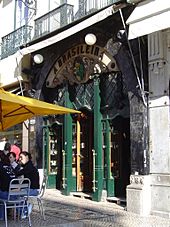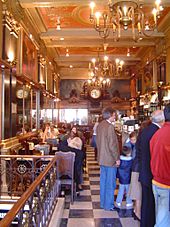Café A Brasileira facts for kids
Quick facts for kids Café A Brasileira |
|
|---|---|
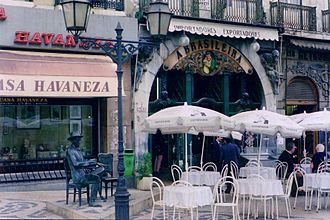
The iconic façade of the Café A Brasileira with the figure of Fernando Pessoa at his usual table
|
|
| Former names | A Brazileira |
| Etymology | Portuguese: "Café of the Brazilian Woman" |
| General information | |
| Type | Coffeehouse |
| Architectural style | Art Nouveau |
| Location | Chiado (Sacramento) |
| Address | 120 Rua Garrett |
| Town or city | Lisbon |
| Country | Portugal |
| Coordinates | 38°42′38.49″N 9°8′31.37″W / 38.7106917°N 9.1420472°W |
| Opened | 19 November 1905 |
| Technical details | |
| Material | Concrete |
| Design and construction | |
| Architect | Manuel Joaquim Norte Júnior |
The Café A Brasileira (which means "The Brazilian Lady Café") is a very famous and old coffee shop in Lisbon, Portugal. It's located at 120 Rua Garrett, in a lively area called Chiado. This café is close to a subway station and a university. It opened way back on November 19, 1905, and quickly became a popular spot. It was started by Adriano Telles to sell special Brazilian coffee, which was quite new in Lisbon at the time. Over the years, it became a favorite meeting place for writers, artists, and thinkers. Today, it's a well-known place for both locals and tourists to enjoy a cup of coffee.
Contents
History of a Famous Coffee Shop
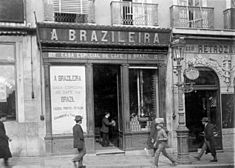
The Café A Brasileira first opened its doors on November 19, 1905. It was started by Adriano Telles, who wanted to sell "real Brazilian coffee" from the Minas Gerais region. At that time, Brazilian coffee was not very common in Portuguese homes. To help people try his new product, Telles had a special offer. If you bought one kilogram of ground coffee, you would get a free cup of coffee to taste.
This café was also the first place to sell the "bica". A bica is a small cup of strong coffee, very similar to an espresso. Adriano Telles had lived in Brazil, so he easily imported not just coffee, but also other Brazilian products like goiabada (guava paste) and tapioca.
In 1908, the café got a new look thanks to architect Manuel Joaquim Norte Júnior. It was updated again in 1922 by architect José Pacheco. This time, the design was in the Art Deco style. It featured a green and gold entrance, shiny mirrored walls inside, and a long, beautiful oak bar.
When Portugal became a republic in 1910, the café became even more popular. It turned into a favorite meeting spot for many important writers, artists, and thinkers of the time. These creative people would often meet there to discuss ideas and even helped start a famous magazine called Orpheu.
After facing some tough times in the 1950s and 1960s, the café managed to stay open. In 1993, it received funds to help restore and update its historic building.
Amazing Architecture and Design
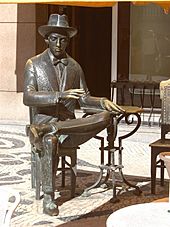
Outside the Café
The building itself is tall and narrow, with two main floors. The front of the café proudly displays its name, A Brasileira, and its address number. The outside has a unique and colorful design. You can see an arched cement front with windows and two figures leaning on either side of the arch. The entrance has three double-doors, with the middle one being the largest. Below the main sign, there's a detailed picture of a man enjoying coffee, surrounded by fancy curved designs.
Inside the Café
When you step inside, you'll find a long, narrow room. The floor is made of black and white marble tiles arranged in a cool pattern. The ceiling has decorative borders, and there are square pillars along the walls. These pillars are also decorated with carved wood. The room is painted in warm colors like yellow-brown, gold, and red. You'll see shiny brass details mixed with the sculpted red wood. Large mirrors are placed between the pillars, making the space feel bigger. At the far end of the café, there's a clock set into a wooden decoration. The main counter is on the right side as you enter, and a staircase leads down to the kitchen in the basement.
Culture and Famous Visitors
The Café A Brasileira was a favorite place for many smart people, including the famous Portuguese poet Fernando Pessoa. Other writers like Aquilino Ribeiro and Alfredo Pimenta also loved to visit. Fernando Pessoa would often come here to enjoy a sweet bica (a small coffee) while he smoked, read, or wrote.
Over its long history, the walls of A Brasileira became like a small art gallery. In 1925, the café started showing paintings by a new generation of Portuguese artists who often visited the café. Some of these artists included José de Almada Negreiros and Eduardo Viana. These artworks were later sold in 1969. The "museum" was updated in 1971 with new paintings from other artists of that time.
In 1988, a bronze statue of Fernando Pessoa was placed permanently outside the café. It was created by sculptor Lagoa Henriques. Even though Pessoa enjoyed A Brasileira, he actually considered the Café Martinho da Arcada (which opened in 1782) to be his absolute favorite coffee shop.
The University of Lisbon's School of Fine Arts is located nearby in the Chiado district. About 1300 students from this school often walk through the area, sometimes competing with tourists for a spot at the outdoor tables of the café.
See also
 In Spanish: Café A Brasileira para niños
In Spanish: Café A Brasileira para niños


